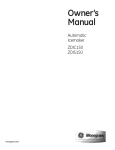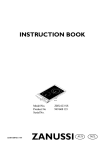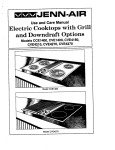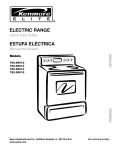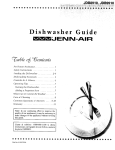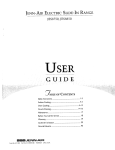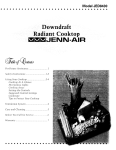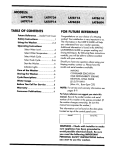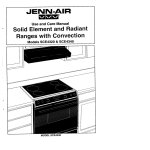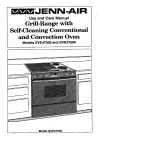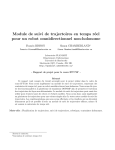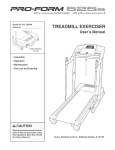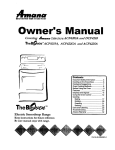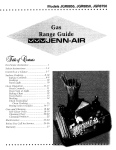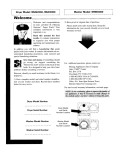Download Jenn-Air 30 in. CCE3401 Electric Cooktop - C:\Documents and Settings\Eddie.EDDOBIN\My Documents\jenair cce3401\CCE3401B
Transcript
JENN.AIR
Use and Care Manual
Halogen, Induction
Radiant Cooktops
L_.
Models CCE3401, CCE3451,
CCE3531 & CVE3400
Model CCE3401
&
Read before operatingyour cooktop
All appliances - regardless of the manufacturer - have the potential
through improperor careless use to create safety problems. Therefore
the following safety precautionsshould be observed:
1.
Be sure your appliance is properly installed and grounded by a
qualifiedtechnician.
2. Never use your appliancefor warming or heating the room.
3. Children should not be left alone or unattended in area where
appliance is in use or still hot. They should never be allowedto sit
or standon any part of the appliance.
4. Wear proper apparel. Loose-fitting or hanging garments should
never be worn while usingthe appliance.
5. Donot repairor replaceany partof the applianceunlessspecifically
recommendedin this manual. All otherservicingshouldbe referred
to an authorized Jenn-Air ServiceContractor.
6. Flammablematerialsshould not be stored near surface units.
7. Do not use water on grease fires. Smotherfire or flame or use dry
chemical or foam-typeextinguisher.
8. Useonly dry potholders. Moistor damp potholderson hot surfaces
may result in burns from steam. Do not let potholder touch hot
heating elements. Do not use a towel or other bulky cloth.
9. Use proper pan size. Many appliances are equippedwith one or
more surface units of different size. Select cookware having flat
bottoms large enough to cover the surface unit heating element.
Theuse of undersizedcookwarewill exposea portionof the heating
element to direct contact and may result in ignition of clothing.
Properrelationshipof cookwareto heatingelementwillalso improve
efficiency and performance.
10. Neverleavesurfaceunitsunattendedathigh heatsettings. Boilover
causes smoking and greasyspillovers that may ignite.
11. Glazed cookware - only certain types of glass, glass-ceramic,
ceramic, earthenware, or other glazed cookpots are suitable for
cooktop surface without breaking due to the sudden change in
temperature. Use only such cookware that you know has been
approved for this purpose.
12. Cookware handles should be turned inward and not extend over
adjacent surface heating elements to avoid burns, ignition of flammable materials and spillage due to unintentional contact with the
cookware.
13. CAUTION - Do not store items of interest to children in cabinets
above a cooktop - children climbing on the cooktop to reach items
could be seriously injured.
14. Do not touch surface units or areas near units. Surface units may
be hot even though they are dark in color. Areas near surface units
may become hot enough to cause burns. During and after use, do
not touch or let clothing or other flammable materials contact these
areas until they have had sufficient time to cool.
15. Do not cook on glass-ceramic cooking surface if the cooktop is
broken. Cleaning solutions and spillovers may penetrate the broken
cooktop and create a shock hazard. Contact an authorized Jenn-Air
Service Contractor.
16. Clean glass-ceramic cooktops with caution. If a wet sponge or cloth
is used to wipe spills on a hot cooking area, be careful to avoid steam
burns. Some cleansers can produce noxious fumes if applied to a
hot surface.
17. Do not operate with damaged cooking element after any product
malfunction until proper repair has been made.
18. Keep all switches "OFF" when unit is not in use.
19. Clean only parts listed in this manual and use procedures recommended.
20. Do not use aluminum foil or foil containers on the cooktop. These
may become very hot.
21. This appliance has been tested for safe performance using conventional cookware. Do not use any devices or accessories that are not
specifically recommended in this manual. Do not use eyelid covers
for the surface units or stovetop grills. The use of devices or
accessories that are not expressly recommended in this manual can
create serious safety hazards, result in performance problems, and
reduce the life of the components of the appliance.
22. Do not let cooking grease or other flammable materials accumulate in or near the appliance, hood or vent fan. Clean hood frequently to prevent grease from accumulating on hood or filter. When
flaming foods under the hood turn the fan on.
-SAVE THESEINSTRUCTIONS3
Congratulations on your choice of a Jenn-Air electric cooktop. The
cooking areas are identified by circles on the glass-ceramic cooktop. This
chart below describes the differences between models.
Cooktop
ModeINo.
30"- 4 elements CCE3401
CCE3451
CVE3400
36"-5elements CCE3531
Type of Elements
3 radiant& ldualradiant
2induction&2radiant
3 radiant& 1dualradiant
3radiant, ldualradiant&
I halogen
Downdraft
no
no
yes
no
Before you begin cooking with your new cooktop, please take a few
minutes to read and become familiar with the instructions in this book.
Should you have any questions about using your Jenn-Air electric
cooktop, write to us, or call. Be sure to provide the model number.
Jenn-Air Customer Assistance
Attn: CAIR sMCenter
P.O. Box 2370
Cleveland, TN 37320
1-800-688-1100
(Mon. - Fri, 8 am-Spm Eastern Time)
Internet: http://www.jennair.com
About Your Cooktop .....................................................................
Before You Call for Service ...................................................
4
18-19
Cleaning ......................................................................................
16
Ducting ........................................................................................
15
Induction Cooking Procedures ...................................................
13
Induction Cookware ....................................................................
12
Important Information ..................................................................
17
Radiant & Halogen Cooking Procedures ............................... 10-11
Radiant & Halogen Cookware ...................................................
8-9
Safety Precautions .....................................................................
2-3
Surface Controls ........................................................................
6-7
Ventilation System ......................................................................
14
1
5
4
I_
1
2,
1.
3.
4.
element on select models)
Left front element
Left rear element (dual
Right front element
Right rear element
2
_.
_:_.
_
2-
-3
4
:i_':
only)
5. (ModelCCE3531
Center rear heating
,,- __
:_:
CVE3400Controls
• The controls are a push-turn type. To turn on the
radiantand halogenelements,pushdownand turn
element, turn clockwisefrom OFF to control the
large
element and counterclockwisefrom
OFF to
ineitherdirection.
Toturn onthedualradiant
controlthe small element. To turn on the induction
elements,pushdown andturn clockwiseto desired
setting.
3
5_
",_Hi
7
(/
9 _J
x/9
3
(,0) o.
• Whenthe controlis inany position,otherthan OFF,
it may be turned without pushing down.
L0
o
Dual ElementControl
Models COE3451& CVE3400- A red indicatorlight will glow whenan element is turned
ON. There is a light for each element.
Models CCE3401 & CCE3531- Whenthe controlknobs are in the OFF position,the only
setting visible is OFF. When the control knob is turned ON, the ring around the control
knob will glow and all other control settings will be shown.
The cooktop has Hot Surface Lights to indicate when each radiant and/or halogen
element cooking area is hot. The red light will remain on untilthe area has cooled. The
induction elements do not have Hot Surface Indicator Lights.
When the induction elementsare ON, a cooling fan will operate. The cooling fan does
not operate with the radiant and halogen elements.
6
The size and type of cookware used and the amount and type of food being cooked will
influence the setting needed for best cooking results. Electrical line voltage may also
vary, which will affect the needed control setting+ The setting indicated should serve as
a guide while you become familiar with your cooktop.
Hi
7-10
5-6
3-4
LO-2
A fast heat to start cooking quickly, to bring liquids to a boil or blanch.
(Medium High) For fast frying or browning foods, to maintain rapid boil of large
amounts of food.
(Medium) For foods cooked in a double boiler, sauteing, slow boil of large amounts
of food, and most frying.
(Medium Lo) To stew, steam, simmer; to continue cooking foods started on higher
settings.
Maintaining serving temperatures of foods, simmering foods, melting butter or
chocolate.
The controls offer flexibility in setting selection. On settings other than Hi, you may adjust
the controls above or below the numbered setting for best results. Suggested settings
are provided as general guidelines.
To achieve optimum cooking performance, use heavy gauge, flat, smooth bottom
cookpetsthat conformto the diameterofthe cookingarea. Propercookpotswillminimize
cooking times, use less electricity, cook food more evenly and require less water or eil.
Cookpots with thin, uneven bottoms do not adequatelyconduct heatfrom the cooking
area to the food in the cookpots which results in hot spots, burned or underdone food.
Impreper cookpots require more water, time and energy to cook food.
• Selectheavygauge¢ookpots.
when heated.
Mostheavygaugecookpotswill notchangeshape
• Use ¢ookpots with flat, smooth bottoms. The two ways to determine ifcookpets
have a flat, smooth bottomare the ruler test and the cooking test.
Ruler Test:
1. Placethe edge of a ruler across the bottom of the pot.
2. Hold up to the light.
3. No light should be visible under the ruler.
1. Put 1 inch of water into thecookpot.
2. Place cookpot on the coeking area. Turn
control to the Hi setting.
3.Observe the bubble formationto determine
Cooking
Test:
the heatdistribution.
If the bubbles are uniform across the cookpot, the cookpot will
perform satisfactorily. Ifthe bubblesare not
uniform, the bubbles will indicate the hot
spots.
I._.,,,.
_
• Matchthesizeofthecookpottothesizeoftheelement.
be the same size or slightly larger.
Use Jenn-Air's flat bottom wok (Model AO142) for
optimumresults. ModelAO 142wok hasa nonstick
finish, wood handles, cover, steaming rack, rice
paddles, cooking tips and recipes.
_.,,
Ideally,thecookpotwill
• Donot use cookwarethat extendsmorethan 1 inch beyondthe edge of the cooking
area.
• Donot usea small cookpoton a largeelement. Not onlycan this causethe element
to require more energyand time, but it can also result in spilloversburning onto the
element which cause extra effort in cleaning.
• Donot use nonflatspecialtyitemsthat are oversized,uneven or do not meet proper
cookware specifications such as round bottom woks with rings, rippled bottom
canners,and oversizedor non-flat bottomlobster pots, large pressurecanners and
griddles, etc.
• Testcast ironwaresince all are not flat. Also be cautioned against possible "impact
damage"should the heavy cookpot be dropped on the glass-ceramicsurface.
Acceptablecanning pots should not be oversizedand must have a flat bottom. When
canners do not meet these standards,the use of the Hi settingbecomes excessiveand
may result in damage to the cooktop. In addition, water may not come to a boil and
canners may not reach 10 Ibs.of pressure.
Theacceptablecanning procedureusesthe Hi settingjust long enoughto bring thewater
to a boil, then lower the settingto maintainthe water temperature.
Heavy gauge cookpots with flat, smooth bottoms will usually work in a similar way.
However,there are some differences in the cooking performanceof various materials.
• Aluminum c5okpots heat quickly and evenly. Best suited for simmering, braising,
boiling and frying.
Note: Aluminum cookpotswill cause metal marks on the glass-ceramicsurface if
you slide them across the cooktop. Remove metal marks immediately.
• Stainless steel cookpots will evenly distribute heat if constructed of tri-ply or
combined with other metals such as aluminum and copper. Use for cooking
functions similar to aluminum.
• Cast iron cookpots are slow to heat but cook more evenly once temperature is
reached. Use for long term low heat cooking or for browning and frying.
• Porcelainenamel-on-steelorporcelainenamel-on-castironshouldbeusedaccording to manufacturer'sdirections. Do not allow to boil dry.
• Glass-ceramic,earthenware,heatproofglass orglazedcookpots may scratch the
glass-ceramiccooktop and therefore are not recommended.
Note Halogen element: Aluminumcookpots maycause theelementto cycle evenwhen
the controlsetting is Hi.
The cooking areas are identified by circles on the glass-ceramic cooktop. When an
element is turned ON, the cooktopwill heat up and the red glow of the heatingelement
can be seenthroughthe glass-ceramictop. It is normaltosee the red glowof theelement
wheneverit is ON.
• BEFORE FIRST USE CLEAN COOKTOP.(See p. 16.)
• For best results, always use recommendedcookware.
• Make sure bottomof cookware is clean before placing on cooktop.
• Covering pans, whenever possible, speeds cooking and is more energy efficient.
This is especially importantwhen cooking large quantities of foods.
• The glass-ceramiccooking area retainsheat for a period of time after the elements
have been turned off. Put this retainedheat to good use. Turn the elements off a
few minutesbeforefood is completelycookedand use the retainedheatto complete
the cooking. Because of this heat retention characteristic, the elements will not
respondto changesin settings asquicklyas cellelements, in the event of a potential
boJlover,remove the cookpot from the cooking area.
• When preparingfoods which canbe easilyscorchedor overcooked,start cookingat
a lowersetting and gradually increase setting as needed.
• A lower setting can be usedwhen cooking small quantities of foods or when using
a cookpot that conducts heat quickly.
• A higher settingthan normal may be necessary when using cookpots made with a
material that is slow to conductheat, such as cast iron.
IMPORTANT
• Donotusewiretrivets, fire rings, padsor anysuch itembetweenthe cookwareand
the element.
• Do not cook foods directly on cooktop.
• Do not allow pan to boil dry as this could damagethe cooktop and the pan.
• Do notslideheavymetal or glasscookpotsacrosssurfacesince thesemay scratch
the surface.
• Do not use or place plastic items anywhere on cooktop.
10
• Do NOT allow plastic objects, sugar, or foods with high sugar contentto melt onto
the hot cooktop. Meltedmaterialscan cause permanent damageto the cooktop. If
you accidentally melt anything onto the cooktop, or a sugary solution boils over,
removeit immediatelywhilethecooktopis still hot. Carefully,usea singleedge razor
blade held with a pot holder to scrape the melted material or sugary boilover to a
coolerarea of thecooktop. Useseveral layersof papertowel to wipeup thespillover,
being careful nottoburn yourself. Whentheelement hascooled, usetherazorblade
to scrape off the remainingsoil and clean asyou would for heavyspills. (See p. "t6.)
• Do NOT use aluminum foil or foil-type containers under any circumstances.
Aluminum foil will damage the cooktop if it melts onto the glass, If metal melts on
cooktop, do not use. Call an autherized Jenn-Air Service Contractor.
• Do NOT use the glass-ceramiccooktop as a cutting board.
• Do NOT useabrasivecleansingpowdersor scouring pads(includingmetalscouring
pads), which will scratch the cooktop.
• Do NOT use chlorine bleach, ammonia, rust removers, oven cleaners, or other
cleanser net specifically recommendedfor useon glass-ceramic.
• Make sure bottoms of cookpots are always clean and dry. (Soil from the cookpot
bottom can be transferredto the cooktop surface.) Before using cookpots on the
g/ass-ceramic cooktop for the first time, and periodically as needed, clean the
bottoms with scouring pads or other cleansers. Rinse and dry thoroughly.
• Make it a practice to wipe cooktop surface with a clean damp cloth or paper towel
beforeeachuse; drythoroughly. Invisiblespatters,dust specks,cleansersor water
cancause stainsthat appear after unitis heated. A spongeor dishclothwhich is not
clean will leave film and soil laden detergent water which may cause stains on
surfaceafter area is heated.
• Whenfrying, use a spatter shield to reduce spattering.
• Use correctcontrol settings and cookware large enough to hold food and liquid to
prevent believers and spattering.
• if a bad spilloveroccurswhile cooking,spills may be cleanedfrom the cooktopwhile
itis hotto preventa toughcleaningchorelater. Usingextremecare, wipewith a clean
damptowel. Be carefultoavoidburnsfrom steamor handstouchingthe hotcooktop.
11
When choosingeookwarefor the induction elements,consider the material,gauge, and
size of the cookware. Note: Cookware does NOT have to be flat for optimum
performanceon the induction elements.
The cookware MUST be made of a ferromagnetic material in order to work on the
inductioncooktop. Todetermine ifa materialis magnetic,testthe bottomofthe cookware
with a magnet, If the magnetsticks to the outsidebottom of thecookware, the cookware
will work on your induction element.
Examplesof magnetic material are:
• porcelainon steel;
• porcelain on cast-iron;
• cast-iron; and
• tri-ply stainless steel,
Examplesof nonferromagneticmaterials,which do NOTwork on the inductionelements
are_
• a(uminumor aluminum clad;
• copper or copper clad;
• porcelainon aluminum;
• glass-ceramic;or
• earthenware.
Cookwarecomes in a varietyof gauge thicknesses. Thingauge pots will performwell in
bringing water to a boil quickly, simmering,and stewing. Heaviergauge skillets provide
a better overall browning pattern.
• Cookpots MUST be at least 4 or more inches in diameter in order to work on the
inductioncooktop.
• For better browningwhen pan-frying, match the bottom diameter of the skillet with
the size of the cooking area.
Use Jenn-Air'sflat bottom wok (ModelAOf 42) for
optimumresults. ModelAO142 wok hasa nonstiek
finish, wood handles, cover, steaming rack, rice
paddles, cooking tips and recipes.
12
An induction cooktop responds like a gas cooktop, quick to heat and instant response
when turned off. The cooking areas are identified by circles on the glass-ceramic
cooktop. When an element is turned ON, the induction coils located under the glass
create a magneticfield. When a ferromagnetic pot at least 4" in diameter is placedon
the element,the pot gets hot.
• Placethe cookpet on the cookingarea beforeturning on the controls.
• DO NOT HEAT AN EMPTY COOKPOT OR SKILLET.
• Since induction cooking is fast, start cooking at the recommendedsetting. For
instancewhen pan frying,start cookingat a mediumsetting. Donot preheata ski}let
at a highersetting. Sincethe skillet beginsto heat{mmediatelywith induct{on,food
could be burned before the control setting was lowered.
• If a food starts to boil over, reducethe control setting. The induction elements wi}l
respondinstantly.
IMPORTANT
•
•
•
•
Do NOT use copper cookware.
Do NOT allow pots to boil dry.
Do NOT heat an empty skillet.
Slowly heat and cool porcelain pots. Rapid changes in temperature may cause
crazing of the porcelainfinish.
Each inductioncooking area has a pot sensorwhich will cause a "beep-beep"to come
on when:
• no cookpot is sittingon the cooking area whichwas turned on.
• element was turned on and cookpot is made from a nonmagnetic material (see
cookware section for examples).
• cookpot is removed from the element without turning off the control.
• size of the cookpot is less than 4 inches in diameter and control was turned on.
13
The built-in ventilation system removes cooking vapors, odors, smoke and steam from
foods prepared on the cooktop. Regular use of this system will insure a more comfortable
and less humid kitchen which is free of heavy cooking odors and fumes that normally
create a frequent need for cleaning and redecorating.
• The fan control is located at the front of the control panel. To operate the ventilation
system manually+ turn the fan control knob clockwise. The variable speed fan can
be operated at an infinite number of settings.
•
Besides using the ventilation system to remove cooking vapors and fumes, it can be
used to cool baked pies, cakes or hot pans. To cool an item, set it on the air grille
and turn on the fan. The air being pulted over the item will quickly cool )t. Be careful
not to cover the entire air grille.
• The fan can be used to remove strong odors from the kitchen as when chopping
onions near the fan.
Air Grille
The air grille lifts off easily. Wipe clean or wash in sink with mild household detergents, it may
be cleaned in the dishwasher.
Filter
Turn off ventilation system before removing. The filter is a
permanent type and should be cleaned when soiled. Clean
in sink with warm water and liquid dishwashing detergent or
in dishwasher.
Important: DO NOT OPERATE SYSTEM WITHOUT FILTER. Filter should always be placed at an angle. As you
face the front of the cooktop, the bottom of the fitter should
rest on the ledge on the right side. The top of the firtershourd
rest against the left side. There are also ledges on the front
and rear sides for the filter to rest. (Note: If filter is flat
against the fan wall, ventilation effectiveness is reduced.)
Ventilation Chamber
This area, which houses the filter, should be cleaned in the event of spills or whenever it
becomes coated with a film of grease. It may be cleaned with paper towel, damp cloth, or
sponge and mild household detergent or cleanser.
14
Jenn-Air's ventilation system is designed to capture both cooking fumes, smoke and
steam. If the system does not, these are some ducting installation situations to check:
• 6" diameter round or 3 V4" x 10" rectangular ducting should be used.
diameter round ducting may be used if the duct length is 10' or less.
Note: 5"
• No more than three 90° elbows should be used. Distance between elbows should
be at least 18".
•
Recommended Jenn-Air wall cap should be used. Make sure damper moves freely
when ventilation system is operating.
• There should be a minimum clearance of 6" for cooktop installed near a side wall.
if there is not an obvious improper installation, there may be a concealed problem such
as a pinched joint, obstruction in the pipe, etc. Installation is the responsibility of the
installer and questions should be addressed first by the installer. The installer should
very carefully check the ducting installation instructions.
15
BEFORE CLEANING, BE CERTAIN ALL ELEMENTS ARE TURNED OFF AND THE
COOKTOP iS COOL.
CAUTION:
Do NOT use a cooktop cleaner on a hot cooktop. The fumes can be
hazardous to your health and can chemically attack the glass-ceramic
surface.
NOTE: Plastic objects, sugar or foods with high sugar content allowed to melt onto
the cooktop can cause damage. See page 11 for cleaning instructions.
• For general daily cleaning and light surface soil, use a clean dishcloth orpaper towel
and wash surface with solution of water and any of these cleansers: dishwashing
liquid such as Ivory or Joy, baking soda, fine polishing powders such as Bon Ami, or
commercial ceramic cooktop cleansers such as Cooktop Cleaning Creme (Part No.
20000001). Wipe with clean damp cloth or paper towel. Rinse and dry thoroughly.
• To remove residue from burned on spills, make a paste of water and baking soda or
Bon Ami, Bar Keepers Friend, Comet, Shiny Sinks or nonabrasive soft scrubbing
cleansers, such as Cooktop Cleaning Creme (Part No. 20000001). Scrub with paper
towels, nylon or plastic scrubber, such as Tufty. Rinse and dry thoroughly. If stain
is not removed easily, allow paste to remain on surface for 30 to 40 minutes. Keep
moist by covedng with wet paper towel or plastic wrap.
• To remove burnt on spot, use a single edge razor blade. Place blade edge on
cooktop at 30 ° angle; scrape off spot. Clean remainder of soil with method described
above.
To remove knobs, turn to the OFF position. Pull each knob strai9ht up from the shaft.
Wash knobs in warm soapy water or dishwasher; do not use abrasive cleaners or
materials. TO replace each knob, match flat part of knob opening with the spring on the
flat part of the shaft, returning to OFF position.
16
Model Number
Serial Number
Date Purchased
JENN-AIR DEALERFROM WHOM PURCHASED
Address
City
Phone
AUTHORIZEDJENN-AIR SERVICE CONTRACTOR
Address
City
Phone
Important:
Retain proof of purchase documents for warranty service.
17
Check the following list to be sure a service call is really necessary. A quick reference
of this manual may prevent an unneeded service call.
If nothing on the cool{top operates:
• check for a blown circuit fuse or a tripped main circuit breaker.
• check if cooktop is properlyconnected to electriccircuit in house.
If cooktop elements do not get hot enough:
• surfacecontrols may not be set properly.
• voltage to house may be low.
• cookwaremay not be flat or the correct size or shape.
If elements emit a slight odor and/or smoke when first turned on:
• this is normal.
If tiny scratches or abrasions appear on cooktop:
• coarseparticles(i.e.sugar,dust,salt) werebetweencookwarebottomsandcooktop.
• incorrectcleaning materialswere used to clean cooktop.
• glass cookware was slid across the cooktop.
• cookwarewith a rough bottom was used.
If metal-markings appear on cooktop:
• metalcookpotsor utensilswere slidacrossthe cooktop.
If brown streaks and/or areas of discoloration with a metallic sheen
appear on cooktop:
• boiloversburnedontothe cooktep.
• mineraldepositsfrom water of food burnedontothe cooktop.
• soil from cookpot bottom was transferred to the cooktop.
• incorrectcleaning materials were used.
Model CCE3451 Only:
If "beeping" occurs when an induction control has been turned on:
• there is no coekpot sittingon the cooking area which was turned on.
• the cookpot is made from a nonmagnetic material (see cookware section for
examples).
• the size of the cookpot is less that 4" in diameter.
It a "ticking" sound occurs when an induction element is on:
• It is normalto hear a slight tickingsoundwhile using an induction element. This can
be more noticeablewith certain types of cookware.
18
Model CCE3451 Only:
If pan frying results are poor:
• bottom diameterof skillet may be too large. (Forbetter browning, matchthe bottom
diameter of the skillet with the size of the cooking area.)
• thin gauge skillets tend to have hot spots.
• too high of control settingwas selected initially. Inductionelements produce HOT
skillets instantly.
Model CVE3400 Only:
If ventilation system is not capturing smoke efficiently:
• check on cross ventilationin room or make up air.
• excessive amount of smoke is being created.
• cooktop may be improperly installed;check ducting information. (See p. 15.)
• air filter may be improperly installed. (See p. 14.)
19



















